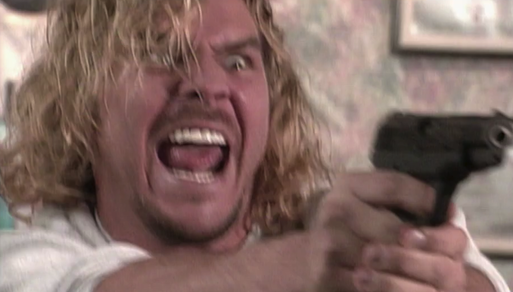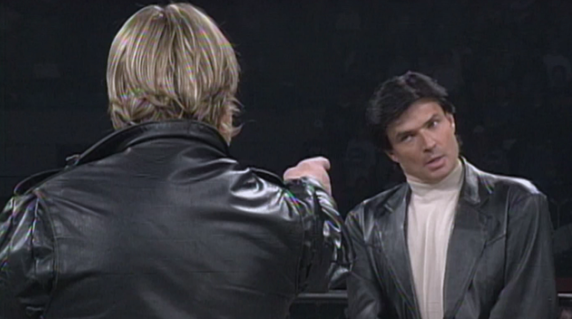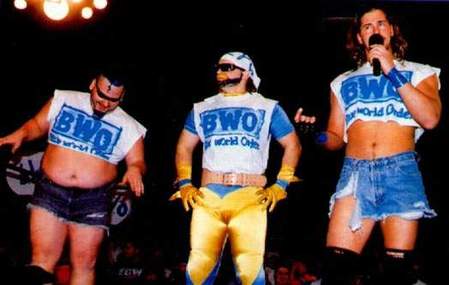Subscribe to the podcast via: iTunes | Spotify | Google | Youtube
1996 WWF was an odd time frame, a balance of the past and an awkward, lukewarm vision of the future melded together in an often ugly and frequently boring mix. While it might surprise people to learn that things were very 'shooty' in 1996, like for instance the time Ultimate Warrior was suspended for no-showing a series of live events and... they just said exactly that on TV, there were also times where things were very much stuck in the past: TL Hopper – a wrestling plumber, The Sultan – whatever the hell Rikishi's latest idea was and just the whole thing that surrounded the "return" of the Fake Diesel and Fake Razor Ramon.
But perhaps the main who best incapsulated the transition from the past to the future was Steve Austin. Debuting as the generic, gimmickless ringmaster he might as well have been called "the mid-carder" such was Vince McMahon's perception of him. The fact that Austin, having torn up ECW for the three months prior, was saddled with a manager points to the idea that McMahon may have, in fact, never watched the character with any great interest.
Brian Pillman too arrived off the back of a series of strong vocal performances, but at least people making decisions in the company seemed to have been paying attention. Pillman's character had every bit of the edge that he had developed in the final months within WCW, and to a lesser extent in ECW. Unfortunately a serious car crash had done some serious damage to his foot, limiting to limping around on crutches and cutting promos in his early run.
While most will point to Austin's victory and subsequent promo at King Of The Ring as the turning point of his career, closer inspection kind of rips this theory apart. Namely that Austin was a late change in the winner of the tournament which was supposed to go to Hunter Hearst Helmsley (never mind that Vader should've won the whole thing anyway). The promos has since become infamous and, in the case of many WWE documentaries created since, the start of Austin 3:16. Which, technically, it was.
But King Of The Ring was in July, and Austin did very little of note for months afterwards. In each of the past two years, the King Of The Ring winner had gone onto face the WWF Champion at Summerslam. This was never, remotely, the case for Austin; and it would've been a fine fit had they just continued the tradtion with Vader. But what was more remarkable with Austin was that it seemed like the main aim of giving him King Of The Ring was to give the Austin character credibility as a man who could hang with and lose to main event talent in the aftermath of Scott Hall and Kevin Nash departing for WCW.
Twice on Raw in the summer of 1996 Austin faced the Undertaker; once he lost by the disqualification, the other he won by count-out. He went deep in the number one contender battle royal, but didn't look like winning it. In September, he faced Shawn Michaels in a match that broke down. As a ratings pattern began that would cause Raw to shift from 9pm to 8pm, Austin was just a guy in a run where almost nothing was compelling and almost nothing was over. Austin included.
Fortunately Austin had one ally in the WWF, or at least one person who identified his talents. When Bret Hart, on television, called Stone Cold Steve Austin "the best wrestler in the World Wrestling Federation", you'd be forgiven for saying "what?". Austin had barely had a match that could be considered decent in his year in the WWF to that point, nor could he point to anything in ECW nor, really, anything from his latter years in WCW to backup the claim. The idea that some people were peddling even in the early-mid 90s (which some people absolutely were) that Austin was a fantastic wrestler and was a star in the making was something that evidence didn't really back up. Still, with the benefit of hindsight, Bret had one hell of an eye.
That all might have paled into insignificance though if Bret had have left for WCW in 1996, as he nearly did. An offer from WCW that would've made him the highest earning wrestler of all-time not named Hulk Hogan was tabled that, by Bret's own admission, would've enabled him to retire on the beach three years later. As I've written about elsewhere, Bret's departure might have killed the whole "Monday Night War" there and then. It would've given the NWO the foe it desparately needed (and no, that wasn't Jeff Jarrett) and it likely would've derailed the idea to push Austin. Without Bret in 1996/97 what becomes of Steve Austin?
Still, it's not a question we ever had to find out, on October 21st on Monday Night Raw Bret returned to television after an absence of over six months to announce that he had re-signed with the WWF, and that he was accept the challenge of the best wrestler in the WWF – Stone Cold Steve Austin. Camera's backstage show a group of wrestlers watching the interview on a screen (before the days of watching it at a really weird angle too), Austin didn't look too fussed – he was too busy getting angry at Pillman who was giddy at the whole thing. Notebale in that backstage exchange was also the appearance of Rocky Maivia.
The week after on Raw things really started to change. It's almost as if they realised that even if Bret saw Austin as a credible challenger, the audience might not. With TV still a pre-taped/insert hodge-podge they had Austin from a WWF studio in Conneticut and Bret from his home in Canada. Austin, who seemingly with an ability to interrupt the commentary feed whenever he liked, was already causing havoc – and after finding out that they'd be live at Brian Pillman's home the following week (a slightly strange announcement), Austin announced he might just pop by.
He wasn't finished, though. Despite the distance Austin managed to muscle his way into a split screen interview with Bret. Bret, for a guy who had been away for six months, had surprisingly little of note to say, unaided by some typically softball questions from McMahon regarding ring rust. Austin, looking on, waiting for his opportunity – pounced. Whether it was by design or not, Austin eviscerated Hart in the space of about two minutes, leaving him with nothing to say. If we're being polite, we'd say that the whole thing gave Austin a credibility boost, but it arguably showed up Bret's own promo deficiencies.
Strangely, that was the last we'd see of Bret before Survivor Series. Austin finished the show throwing a WWF production assistant into a ladder before the show closed with Austin leaving the studio and being met by Police officers. The inference, I think, was that they wanted to talk to him, rather than they were here to arrest him. The segment was probably the most interesting thing to have happened on Raw in the three and a half years since the show first aired, more the shame that hardly anyone was watching. The show was only two weeks removed from the Raw that did a 1.8 rating (the show that Dave Meltzer always references as the "since late 1996" when talking about what modern day Raw has to compare to). Two weeks on and it drew a 2.0 as Raw continued to sag against Nitro. The lack of significant uplift for either this angle or, more pertinently, the Raw prior where Bret returned, forced the WWF along with the USA Network to shift Raw forward an hour.
(Incidentally, a rumour made the rounds the following month that there was a consideration to moving Raw to midnight on Monday's. Quite how true that is I don't know, but it's fascinating to think what the wrestling world might be like these days had they have done it).
Which brings us to Monday November 4th 1996. On the previous weeks Raw, having found out a WWF crew were going to be at Brian Pillman's house the following week, Austin had made a promise that he was going to show up. On the back of that news Raw on the 4th had an altogether different feel with the show opening, cold, with Kevin Kelly stood outside of Pillman's house.
What followed in the next 45 minutes was in many ways two very different shows. The in ring product had been taped weeks ago, very probably the night where Bret returned. The line-up, by any standards, was horrendous: The Stalker vs Goldust, The Sultan vs Salvatore Sincere and, in the main event, the fake Razor Ramon pinning Marc Mero. The only thing of note on the entire show was an in-ring debate between Shawn Michaels and Sid in an attempt to kickstart that program. More on that later.
We get a cut in with Doc Hendricks, who says that Steve Austin has been in touch and he's in a car leaving Cincinnati Airport. Austin gets a live line into the show and says he will "strike down upon his ass with great vengeance and furious anger" before later adding "I've got a six pack of whoop ass riding shotgun with me". On the threat made by Pillman that he might have a gun Austin simply said he didn't have the guts.
We rejoin Kevin Kelly, this time inside Pillman's home along with his wife. Pillman says that he knows Austin's strengths and his weaknesses but that "Austin 3:16 will meet Pillman; nine milimeter" and pulls out a gun and cocks it. The segment abruptly ends amongst much noise from the people inside the house. What follows, it should be said, is wonderful. We segue beautifully from that horror movie style scene to a WWF commercial promoting the "Karate Fighters" toy and a quarter final match-up between Sid and Sable. Yep...
After a real commercial, we see Steve Austin outside Pillman's home beating up a couple of Pillman's friends in a comedic beat-down that probably didn't really convey the severity of the situation. Still, Pillman's wall of defence was down, now Austin just had to find a way in. After failing to get in the front we of course cut back to Raw for a match involving the Sultan. Yep... We quickly return to Cincinnati after its conclusion and we see Austin smash in a window of a side door and use that to get in. In amongst much hollering and noise Austin paces into the main part of the Pillman house only to find Pillman pointing a gun at him. And that's when we "lost" the feed.
Now, clearly they had to do something here. Pillman letting off a live round (blank or otherwise) in a small room in a crowded situation wasn't a smart idea, nor was leaving the camera rolling. The strength in the segment, in a weird kind of was, was the implied mystery. Basically, had Pillman just murdered Steve Austin? Still, we had a Raw to show viewers and they were going to get that show.
Unfortunately, when you leave on a cliff hanger like DID-SOMEONE-JUST-DIE, the normal wrestling angles you're showing can feel a little bit insignificant in comparison. Take for instance the Shawn Michaels and Sid segment that followed. The crowd were subdued anyway (they were into the third hour of the taping) and the Shawn/Sid rivalrly to date had been a bit flat. We got a podium confrontation in a segment that was largely memorable for Sid saying "first of all, that's bullshit" and generally just talking nonsense. The segment didn't really lead anywhere and the pair were put out of their misery when Jim Cornette and his crew ran out. The tag title match teaming Shawn and Sid took priority over their title match six days afterwards.
They had basically blown the entire Austin/Pillman idea within two scenes, so they spent the rest of the show largely treading water, with "Kerwin" from production phoning in to say the power had gone out and there had been "explosions" heard. We got to about 40 minutes and Vince McMahon, finally, says that the health of those involved is the most important - thanks Vince. Anyway, the live audience and us at home both get to watch Razor Ramon defeat Wildman Marc Mero, thanks to the loosest of "distraction finishes". After that we finally return to Cinncinatti to see the final act, a largely underwhelming pull apart as Austin returned to the living room, the only thing of note was Brian Pillman sneaking in the word "fucking", something that was likely planned well ahead of time. In a weird way, it was quite strange that the big story coming out of the angle was more that the swearword made it to air than Pillman had pulled a gun.
As for whether the whole thing was a success, it's difficult to say. Raw still got soundly beaten by Nitro in the ratings, but ratings for the show climbed throughout the hour before tailing off right at the end (fake Razor Ramon will do that to you), and the show should've got hammered moving to a new timeslot. It did a good job at getting over Pillman's insane character, and also had a strong role in making Steve Austin look like a badass. Whether it did anything to help Bret vs Austin wasn't clear, nor was it clear whether Pillman was going to be returning to in-ring action at any time within the following six months to remotely capitalise on the story – he actually got injured during the confrontation.
Do we give them credit for creating something memorable? I suppose. Raw had been flat for most of the year so much like the week previously we should put a tick in the positive column for creating some noise at least. It was, briefly, absolutely compelling television, but it almost felt like it fell into the category that Vince Russo often talked about (of wanting to have a wrestling show without any wrestling) - what did it matter? It killed the rest of the show, and derailed an important chapter in the admittedly flat Shawn and Sid feud.
Guns in wrestling have never worked, and they never will. Not that this was ever really the point, it was less about Pillman shooting Austin and more of showing how fucking insane Pillman was. But there's almost something to be said that the gun actually constrained them, creatively – once Pillman pointed the gun at Austin they had to cut away, and it's pretty clear that they had nothing to offer after that. Maybe the gun made the angle what it was, but it also probably hamstrung it too far. All in all, memorable, but it's hard to ascertain its effectiveness.



 RSS Feed
RSS Feed